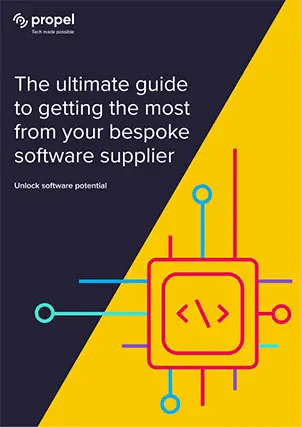04/06/2025
Should you modernise or rebuild your software?
In a world of AI acceleration and constant digital reinvention, established software systems are often underestimated. But with the right approach, your existing systems can become the perfect foundation for modern AI tools — fast, secure, and future-ready.
Many older systems were built with robust architecture and domain knowledge that’s hard to replicate from scratch. With expert assessment and targeted upgrades, in many cases, these systems can be modernised to integrate with AI platforms, cloud services, and analytics - without tearing everything down.
At Propel Tech, we believe the smartest digital transformation often starts with the tools you already have.
What is “legacy software”?
Legacy software refers to older applications that still play a critical role in daily operations. These systems may no longer be updated by the original vendor or built on modern frameworks, but they can still power essential workflows, from inventory management and finance to HR and CRM.
In fact, some of the most respected global brands still rely on legacy platforms, and do so securely and successfully.
Popular legacy systems still in use today
You might be surprised to learn just how much of the world runs on established tech:
- COBOL-based systems still process billions of financial transactions daily, especially in banking and government.
- SAP ECC, the older generation of SAP’s ERP platform, remains the foundation for thousands of manufacturing, logistics and retail firms.
- Mainframes (like IBM Z Series) power many mission-critical operations, thanks to their unmatched reliability and security.
- Microsoft Access underpins many back-office solutions in healthcare and local government.
Legacy doesn't mean obsolete. It can mean stable, secure and, with a little help, ready for what’s next.
When should you modernise – and when should you rebuild?
Before reaching for the new tech stack, take a step back. Here are 4 key questions to ask your development team (or a trusted partner):
1. Is the core functionality still valuable?
If your system handles its primary job well and aligns with business goals, it may just need a facelift not a full replacement.
Tip: Focus on performance bottlenecks, not the entire system.
2. Can it be integrated with newer tech?
Many older systems can now connect with modern APIs, cloud services or AI tools, dramatically improving their usability and extending their lifespan.
Tip: Ask developers if “wrapping” or API-layering could bring new life to your current system.
3. Is the tech stack well understood by your team?
Replacing a system means retraining your team and possibly losing internal knowledge. If your devs understand the current system well, it could be a strategic advantage.
Tip: Retain what works. Build upgrades around your people’s strengths.
4. What’s the risk of downtime or data loss?
Swapping systems is disruptive. For organisations with 24/7 ops, staged modernisation ensures minimal risk while still delivering improvements.
Tip: Choose an incremental roadmap, starting with the highest-impact, lowest-risk areas.
Tips for auditing your existing software
If you’re considering modernisation, start here:
1. Conduct a Legacy Audit
Assess:
- System speed and reliability
- Support and documentation status
- Developer familiarity
- Data accessibility and portability
Ask Propel Tech for a Free Legacy Audit to get expert eyes on your systems with no pressure: https://propeltech.co.uk/contact-us/
This will include a expert review of:
- The quality of the code
- Identification of technical debt
- How secure is the software?
- Guidelines for how to improve your software development life cycle
- Is your system AI ready?
2. Evaluate Security Gaps
Legacy systems aren’t necessarily insecure, but they often lack modern protections. Check for:
- Encryption standards
- Access controls
- Audit trails and compliance readiness
3. Test Integration Potential
Can your system connect with:
- Cloud platforms (Azure, AWS)?
- APIs?
AI tools or analytics dashboards?
Businesses winning with legacy systems
- YourMove & LSL Property Services modernised their internal systems with Propel Tech, unlocking faster workflows and better compliance without rebuilding everything.
- A major UK manufacturer integrated AI tools into their existing production systems, improving inspection speed while maintaining uptime.
- Prime Systems, a risk management platform, transitioned its legacy codebase into a flexible, secure architecture, ready for future growth.
These wins weren’t about scrapping the old. They were about unlocking what was already there. Read Propel Tech’s case studies here.
Is your software worth saving?
If you answer "yes" to three or more of these questions, modernisation is likely a better path.
- Does the system still perform a critical function?
- Can developers still maintain or understand the code?
- Is the system’s architecture modular or layered?
- Are there security patches or workarounds available?
- Can the system be containerised or virtualised?
- Is the cost of downtime for replacement high?
The fastest route to future-ready systems isn’t always a fresh start. It’s often a smarter evolution.
With budget constraints, proven functionality, and talented teams already in place, modernising your software may just be the most agile move you can make.
Talk to Propel Tech
Please get in touch to book your FREE SOFTWARE AUDIT, or to simply discuss whether to modernise or rebuild is the way ahead for you.







